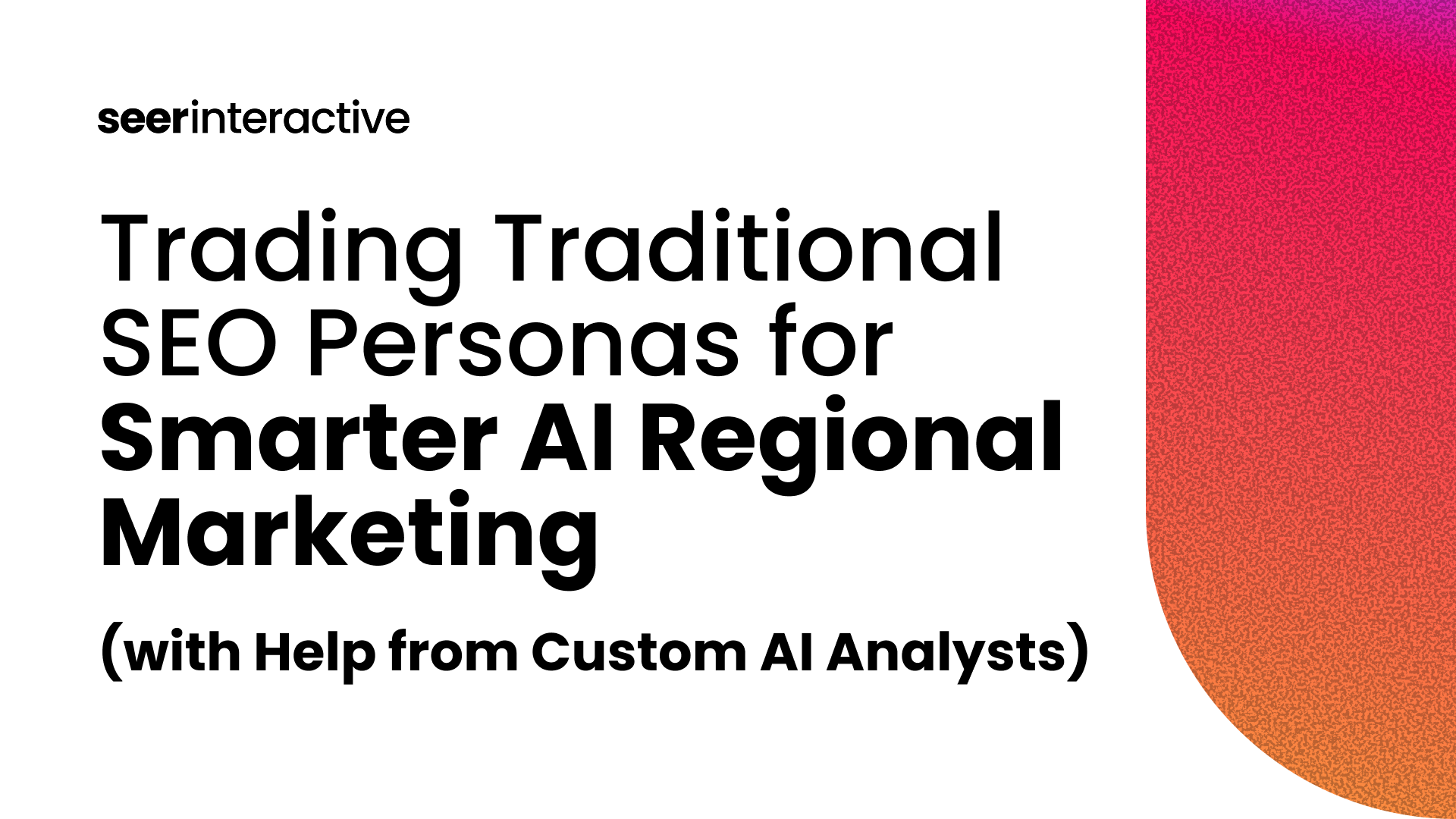Have you noticed that all the Q4 planning content out there seems to almost always be E-comm or retail-focused? Well, non-retail advertisers, I see you and this blog is for you.
I’ll be going over the two biggest external factors that will impact performance and opportunities to test in Q4.
External Factors That Impact Digital Marketing Performance
Q4 (October - December) can be a wonderful time for families and children, but planning and adjusting for it can get stressful for digital marketers.
To help with your Q4 planning and alleviate stress (hopefully), it’s important to consider external factors that could impact performance.
Doing so now can help set expectations beforehand instead of trying to readjust goals after launch.
The Impact of Retail’s Holiday Messaging
If you think this doesn’t impact your brand because you’re not in the retail or E-comm space, you’d be wrong.
E-comm / retail companies throw a lot of money into their marketing efforts to capitalize on holiday shopping. When I worked in-house for an E-comm company, October - December made up the highest revenue value. It also served as the beginning of our fiscal year.
So what does this mean for non-retail companies? Retail is vying for your customer base’s eyes and conversions. As a result, your cost pers will more than likely go up while CTR and engagement go down.
Travel and hospitality companies may even start their holiday messaging sooner to target consumers who are planning holiday travel. I’m willing to bet holiday travel messaging will start soon after back-to-school season finishes.
[TIP] If you’re incorporating anything holiday-related into your messaging (even if it’s colors or some cute wordplay), it’s important not to start holiday messaging too early. Consumers may get fatigued too soon, which negatively impacts performance.
Holiday messaging is an annual thing to consider while planning, but let’s not forget that it’s a presidential election year.
Election Year’s Impact on Digital Marketing
We often see a decrease in performance when it’s an election year; I anticipate it to be more severe because of the current economic climate.
Just like E-comm, political ads can drive up your cost pers and decrease impression share.
According to Axios, US elections and advocacy issue’s ad spend is expected to grow to $16 billion, a 31.2% increase since 2020. Although most of the spend will more than likely go to local news, the increased budget is going toward digital marketing efforts.
Source: Axios
Another surprising effect of an election year is that your impression share and reach may decrease because of excluded publishers or content types. If you do not want your ads to appear near political content, your placement options might be limited. This is because sites and content creators are going to be talking about the election and political climate heavily in Q4.
Which Digital Marketing Platforms Will Be the Most Impacted by the Presidential Election?
During the 2024 presidential election season, most digital marketing platforms will more than likely see a decrease in impressions, reach, engagement, and conversions. You might also want to factor in potential emotional displacement caused by political content.
That being said, the severity of the impact of the presidential election varies among platforms.
CTV
I’m predicting that CTV will experience the biggest performance impact. Like I said earlier, a lot of money is going toward local news. Many CTV placements appear on local news channels.
For example, my team is running a LinkedIn CTV campaign and 70% of placements were on local news channels. I’m predicting increased CPMs, decreased impression share, decreased reach, and decreased engagement.
YouTube
At number two, we have YouTube. Advertisers can exclude what kind of content their ads will appear on, but the exclusion does not apply to what kind of ads it appears with.
If you’re not on YouTube Premium, you can see up to three ads during a video ad break. This means that your video ads may appear alongside unskippable political ads. As a result, a user may displace their emotions from a political ad onto your brand. It can severely diminish your ad’s effectiveness and harm your brand image.
Display
Most digital marketers use display for an awareness play. If you do exclude political content publishers, and/or politically-related keywords, your placement opportunities will decrease severely.
You’ll probably see decreased impressions, reach, and higher CPMs.
X (formerly Twitter)
Full transparency, I recommend limiting or pausing ads on this platform during Q4 and part of Q1 2025. If you do not want your content to appear by political content, this platform is not for you.
According to Pew Research, 74% of X users see political content and 14% share it. This was based on a survey from Q1 2024.
Advertisers can exclude keywords from their ad campaigns, but if 74% were already seeing political content in Q1, those numbers will more than likely increase by Q4, and the opportunities for your ad to be showcased will decrease.
As a result, this can really drive up your cost pers and frequency in a short amount of time.
Next would be Reddit. There are active communities dedicated to political topics. Reddit ads also gives you the option to exclude topics or communities where you don’t want your ad to appear.
That being said, even if you do exclude political content, people will still see it as a trending thing on their feed, even if it’s not a community they actively follow.
If Redditors see your ad in r/puppysmiles (highly recommend BTW), they may not be in a receptive state because of the political content they were exposed to prior. Hence why advertisers may see decreased engagement, CTR, and increased cost pers.
Meta
When I say Meta, I am specifically looking at Facebook and Instagram. Like the other platforms, Meta offers advertisers ways to help prevent their ads from appearing near political content. It also has limitations on political advertisers.
Advertisers are able to go into ads manager and exclude those who are interested in different political-related content (in and off-platform).
According to a study done in March 2024 by Pew Research, 52% of Facebook users report they see political content on the platform; I anticipate that number will increase as we get closer to the 2024 presidential election.
Even if advertisers exclude ads from appearing near political content, it won’t apply to friends or accounts they follow (unless the account specifically calls out that they’re a political commentator, politician, news source etc).
This is just a tiny sample of Meta ads that include the term ‘president’
Source: Meta Ad Library
Advertisers will likely see an increase in cost pers because there is more competition and users may experience emotional displacement because of the political content on the platform.
[TIP] You may want to turn off ads on November 5, 2024. Users and content creators are going to be heavily focused on election day, and users will more than likely not convert.
TIkTok
As with the other platforms, TikTok does offer advertisers ways to help prevent their ads from being seen near political content. However, it’s not 100% and it’s under the discretion of the TikTok creator.
If the creator doesn’t use tags or captions related to politics, or if TikTok’s algorithm hasn’t tied those tags to politics-related content, your ad can appear by political content.
For example, social media users have been using the watermelon emoji to show solidarity with Palestine. This was to prevent demonetization, shadow-banning, online-censorship, and to combat the algorithm.
Just like the digital marketing platforms above, the audience may displace emotions onto your brand, and ad effectiveness could decrease.
There are currently 1.7 million posts that use #vote, and it’s only July
Source: TikTok
I predict there will be an increase in competition with advertisers motivating Millennial and Zoomers to vote, since they are underrepresented at the polls.
Digital Marketing Opportunities to Test in Q4
Test Initiatives, or Allocate Budget to ‘Safe’ Digital Marketing Platforms
Despite what I’ve said so far, Q4 doesn’t have to be doom, gloom, and where digital marketing performance goes to die. Q4 can also be a great time to run tests and try something new.
LinkedIn is primarily more business-oriented, which reduces the likelihood of inappropriate or controversial content. Unlike other digital marketing platforms, it has more strict content moderation.
From an advertising standpoint, LinkedIn targeting options are based on professional criteria, which reduces the likelihood of appearing alongside controversial content.
[TIP] Turn off LinkedIn Audience Network from your campaigns during Q4, to help prevent your ads from appearing near political or potentially controversial content.
You may think Pinterest is only for E-comm and retail, but this a great platform for other industries as well, even B2B!
Pinterest is positioning itself as a ‘feel-good’ platform and it’s very strict in its content moderation. They want their users to feel happy and safe.
That being said, Pinterest users are high intent and already in the mindset to get inspired/influenced. They are actively searching for content. On other social media platforms, users may be more generally browsing with varying intent and passively consuming content.
Content on the platform has a longer lifespan than content on other platforms; users can save pins to revisit later, while other platforms may get an immediate engagement with a shorter content lifespan.
For example, let’s say you are a non-profit focused on dog-fostering and adoptions and you’re looking for donations and volunteers in a specific area. You can use Pinterest to create a prospecting / top funnel audience to target those who have shown interest in volunteering, dog care, adoptions, and other related interests/keywords in a specific area.
Pinterest is a great avenue for retargeting audiences for B2B companies as well. You can create this retargeting audience based on lists or website visitors. As for ads, you can utilize graphs, charts, and other supplemental information to push them down the funnel.
Additional Digital Marketing Tips
Before Q4, I recommend auditing your placements, exclusions, audiences, and creative. This helps see if things need to be refreshed or optimized
I also recommend fine-tuning your prospecting audience before November, so you can get ahead of the 2024 presidential election and holiday promotions. Once it’s fine-tuned, I would allocate more budget to remarketing efforts.
Final Thoughts
Digital marketing performance is expected to dip in Q4 due to annual holiday messaging, and the 2024 presidential election. Advertisers need to include these external factors when planning for Q4’s campaigns and KPIs.
If you’d like to see what state your account is in, and any additional ways to prepare for Q4, contact us!


.png)